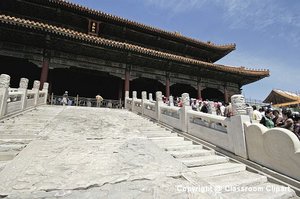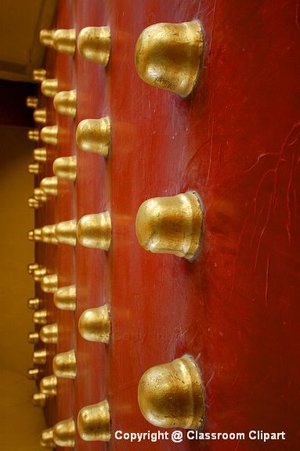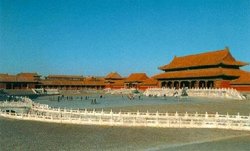Forbidden City
|
|

The Forbidden City or Forbidden Palace located at the exact center of the ancient City of Beijing, was the imperial palace during the mid-Ming and the Qing dynasties. Known now as the Palace Museum ({{zh-cp|c=故宫博物院|p=G?p;#333;ng B?), its extensive grounds cover 720,000 square meters, 800 buildings and 9,999 rooms. (It should not be confused with the National Palace Museum in Taiwan.) As such, it is listed by UNESCO as the largest collection of preserved ancient wooden structures in the World, and was declared a World Heritage Site in 1987. The Imperial Palace grounds are located directly to the north of Tiananmen Square and are accessible from the square via Tiananmen Gate. It is surrounded by a large area called the Imperial City.
Although no longer occupied by royalty, the Forbidden City remains a symbol of Chinese sovereignty and the image of its entrance gate appears on the seal of the People's Republic of China. The Palace Museum is now one of the most popular tourist attractions in the world. Recently, the site has been under much renovation which has limited visitors to the main courtyards and a few gardens.

| Contents |
History
The construction of the Forbidden City started in 1406 and took 14 years and an estimated 200,000 men. From its completion in 1422 to 1644, when a peasant revolt invaded it, the Forbidden City served as the seat of the Ming Dynasty. The following Qing Dynasty also occupied the Forbidden City. After being the home of 24 emperors—fourteen of the Ming dynasty and ten of the Qing—the Forbidden City ceased being the political center of China in 1912 with the abdication of Pu Yi, the last Emperor of China. He was, however, allowed and in fact required to live within the walls of the Forbidden City, until a coup launched by a local warlord in 1924. Having been the imperial palace for some five centuries, it houses numerous rare treasures and curiosities. In 1947, after they had been moved from one location to another inside mainland China for many years (most recently to hide from the Japanese in the war), Chiang Kai-shek ordered many of the artifacts within the Forbidden City to be moved to Taiwan where they formed the core of the National Palace Museum in Taipei. This action has been extremely controversial, with some regarding it as looting while others regarding it as safekeeping, especially with the events of the Cultural Revolution on the mainland.Forbidden_City_Imperial_Guardian_Lions.JPG
Layout
Rectangular in shape, it is the world's largest palace complex and covers 720,000 square meters. Surrounded by a six meter deep moat and a ten meter high wall are five halls, seventeen palaces, and numerous other buildings, the Forbidden Palace is reputed to have a total of 9,999.5 rooms. (The half-room, apparently, houses nothing more than a staircase. As the Forbidden City was on Earth, it was impossible to have 10,000 rooms, which would conflict with the number of rooms in the version found in Heaven, the number 10,000 also symbolizing infinity.) The wall has a gate on each side. At the southern end is the Meridian Gate (technically, Tiananmen Gate is not part of the Forbidden City), to the north is the Gate of Divine Might, which faces Jingshan Park. The distance between these two gates is 960 meters, while the distance between the gates in the east and west walls is 750 meters. The walls are thick and squat and were specifically designed to withstand attacks by cannons.
There are unique and delicately structured towers on each of the four corners of the curtain wall. These afford views over both the palace and the city outside. The Forbidden City is divided into two parts. The southern section, or the Outer Court, consists of five halls used for ceremonial purposes. These include the magnificant Hall of Supreme Harmony (太和殿), itself fronted by the Gate of Supreme Harmony (太和門). The northern section, or the Inner Court, was where the Emperor worked and lived with his family, eunuchs and maid-servants.
ImperialRoofDeco.jpg
At the northern end of the Forbidden City lies a kind of park within the Forbidden City itself. It is home to some relatively old trees - most are between 100 to 300 years old, with some older than 300 years. Hills are also seen. It is all rather small, or shrunk in dimension. Not to fear for the park fan: just north of the Forbidden City is Jingshan Park, which makes the park in the Forbidden City look tiny.
Since the 1949 revolution, Tiananmen Gate in front of the Forbidden City has had a picture of Mao Zedong and two placards. The left one reads 中华人民共和国万岁 (zhōnghuᠲ鮭�g駵nsu컠"Long Live the People's Republic of China"), while the right placard reads 世界人民大团结万岁 (sh쪩蠲鮭�tu᮪i頷ளu컠"Long live the Great Unity of the World's Peoples"). The phrasing has great symbolic meaning, as the phrase used for long live, like the palace itself, was traditionally reserved for Emperors of China, but is now available to the common people.
Major buildings include:
Tiananmen Gate, at the south of the Forbidden City.
Zhongnanhai, the complex of buildings which serves as the central headquarters for the Communist Party of China, is adjacent to the Forbidden City, and located on its western side.
Pictures of the Forbidden City
Classroom Clipart: Pictures of the Forbidden City (http://classroomclipart.com/cgi-bin/kids/imageFolio.cgi?direct=Countries_and_Cities/China/Forbidden_City)
Lesson Plans and Activities
- Forbidden City Webquest (http://www.yesnet.yk.ca/schools/wes/webquests_themes/china_webquests_sofie/forbidden_webquest_sofie/forbidden.html)
- The Forbidden City Lesson Plan (http://school.discovery.com/lessonplans/programs/forbiddencity/)
Reference
Ho and Bronson 2004. Splendors of China's Forbidden City. ISBN 1-85894-258-6.
External links
- Palace Museum official site (http://www.dpm.org.cn)
- Photos (http://www.drben.net/ChinaReport/Beijing/Landmarks-Hotspots/Gugong-Palace_Museum/Forbidden_City_Beijing.html)
- Links (http://www.drben.net/ChinaReport/Beijing/Landmarks-Hotspots/Gugong-Palace_Museum/PalaceMuseum-OnlineSources1.html)
- Forbidden City Map (http://www.drben.net/ChinaReport/Beijing/MapsofBeijing/Forbidden_City-Gugong_Maps/ForbiddenCityMap1.html)
- World heritage virtual tour via imersive panoramas (http://www.world-heritage-tour.org/asia/cn/beijing/gugong/map.html)
- Forbidden City Introduction (http://www.beijingservice.com/forbiddencity.htm)

